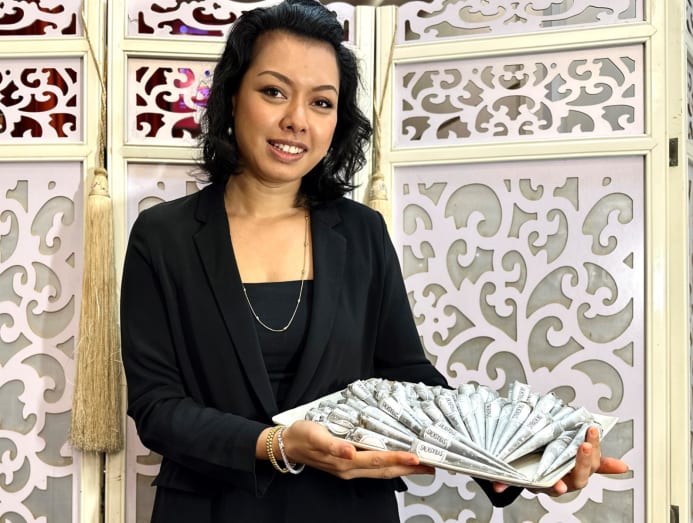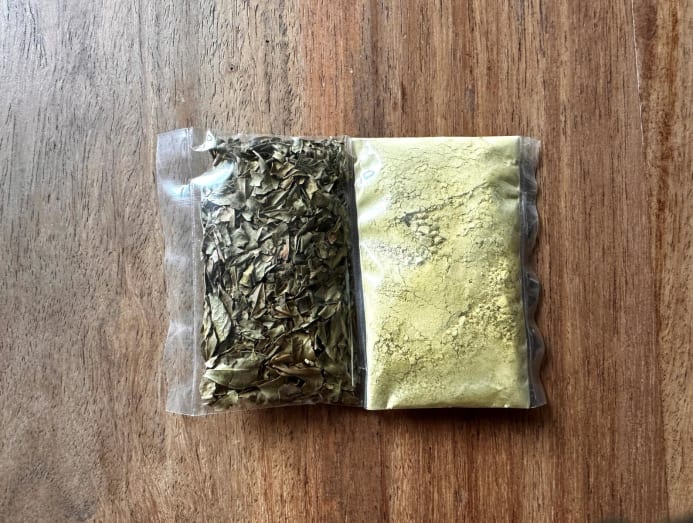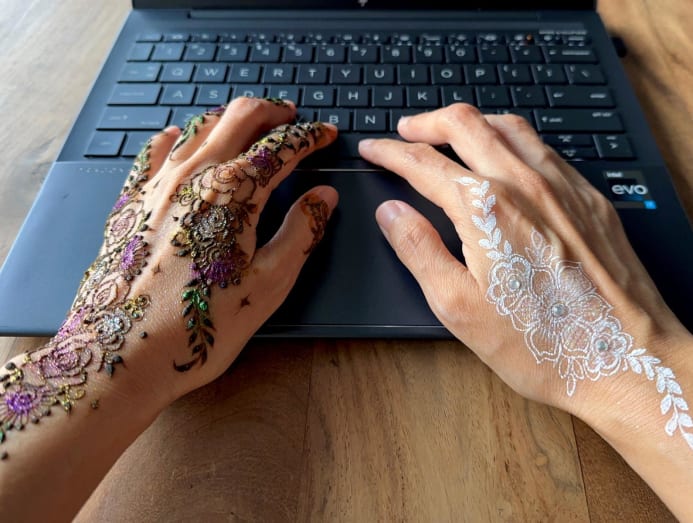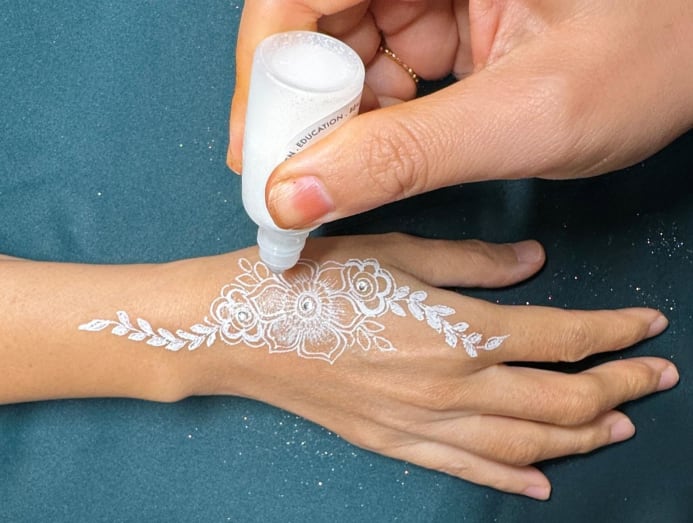View this post on InstagramA post shared by INSPIRE EMPOWER HENNA & JAGUA SINGAPORE (@syraskins)
Henna 101: We ask an artist all about this traditional art form and what you need to know before getting one
There is something about henna art that is as beautiful as it is meditative to see being created right before your eyes.
In the hands of henna artist Syra Gulam from SyraSkins, each delicate squeeze of the henna cone she wields birthed dots, lines, circles, swirls and teardrops on bare skin. As these elements linked up, they formed intricate designs that draped the curves of the hand, forming lattices and blooms trailing down the wrist and fingers.
“It is therapy for me,” Syra said of her freehand drawing process. “It makes me focus on the present, the now, which many of us don’t in our busy lives.” The 35-year-old mother of two shared that henna is a way for her to connect with her community, customers and loved ones.
Syra’s love for henna was honed at an early age by her Chinese mother, who picked up the art from her Pakistani father's family. “In the early days, henna was applied using sticks,” she said. “It was only in the 90s when henna cones were introduced.”

As one of the OG henna artists in Singapore (SyraSkins opened in 2009), Syra has seen the growth of henna’s popularity, from when Madonna wore henna in her Frozen music video in 1998 to helping the National Heritage Board document henna art as an Intangible Cultural Heritage in 2024. She has also shared about henna in San Francisco in 2020.
WHAT IS THE PURPOSE OF HENNA?
The word “henna” can be used to refer to three things: The paste that you draw the designs with, the designs themselves as well as the plant where you get henna from. Henna is also known as mehndi in Indian or inai in Malay cultures.
In Singapore, henna is used traditionally by women from the Indian and Malay communities during weddings, pregnancies, baby showers and to celebrate festivals such as Deepavali and Eid. Today, henna is seen as body art, even appearing in fashion shoots and as a “preview” for tattoos for both genders.
“Sometimes, we get men who want to gauge whether the tattoo design they want is big enough, nice enough. So, the henna version is like a preview before the commitment,” said Syra.
Henna is also used as a natural hair tonic and to soothe and cool skin as well as a hair dye and even brow dye, she added.
WHAT IS HENNA MADE OF?
Natural henna is derived from the ground dried leaves of lawsonia inermis, a shrub that grows in the tropical and semi-arid areas of Asia, Middle East and north Africa. Syra, who sources her henna leaves from Rajasthan, said that hotter and drier regions tended to yield the coveted darker-staining henna.
Interestingly, mothers-in-law used to inspect a new bride's henna on her wedding day to assess the deepness of the stain, said Syra. The darker the henna, the more patient the new wife.
To make the paste as smooth as possible, which makes for easier drawing, the dried leaves are ground into powder and sieved several times before it’s mixed with water, lemon juice and sugar. “The lemon juice acts as a natural preservative, while the sugar helps to make the paste stringy when you squeeze it out.”
When henna was first sold in Singapore in the early 90s, said Syra, it was neither locally made nor did they smell nice. “There were some from Middle Eastern countries that even smelled like a gas station probably because they used kerosene instead of plant oils.”
Other toxic additives that could be used included lighter fluid, paint thinner, benzene and p-phenylenediamine (PPD), according to Syra. PPD is commonly used in hair dyes in concentrations of less than 3 per cent; in imitation henna, it can contain as much as 10 per cent to 40 per cent, she said.
Syra makes her henna with cajeput, tea tree, lavender, rose and geranium oils as well as alcohol-free rose water from India.

OTHER THAN SMELL, WHAT ELSE SHOULD WE STAY AWAY FROM?
Keep away from packaging that reads “instant”, “fast”, “quick”, “maroon henna” or “immediate henna”. “If you see any of these words, you don't want them because they may cause chemical burns,” said Syra.
HENNA THAT LOOKS WHITE OR DARK BLUE: WHAT ARE THEY MADE OF?
The white ones are drawn with a preformulated ink that’s like waterproof liquid eyeliner, said Syra. “There is no henna.”
Deep-blue henna designs are created using jagua henna or hengua, a mixture of jagua fruit juice and henna powder. Jagua is a fruit from the genipa americana tree that grows in Central and South America.
According to Syra, jagua is picked when unripe, then peeled and pressed for the juice. The juice is mixed with henna powder into a paste and used to draw designs on skin. The initial stain starts off as a light grey and progresses to a deep blue that resembles tattoos within 24 hours.
But the jagua henna is less forgiving; it stains as soon as it touches skin, unlike regular henna, which gives a three-to-five-minute window for making corrections.
HOW LONG DO THE VARIOUS HENNA TYPES LAST?
Henna takes about 30 minutes to dry (about 15 to 30 minutes for jagua henna), so don't bump into things and smear the design during that period. It is recommended to keep the dried paste on for at least six hours or even overnight to attain a stain that's as deep as possible. For jagua henna, it's a shorter duration of at least two hours.

The deep-orange to brown stains from henna as well as the dark-blue ones from jagua henna can last for up to two weeks, depending on how fast your skin sloughs off dead cells, according to Syra. The white henna is made to last one to three days at the most.
IS THERE ANYONE WHO SHOULDN’T GET HENNA?
Yes, if you have a glucose-6-phosphate dehydrogenase or G6PD deficiency, said Syra. The application of henna can cause serious complications such as severe jaundice and the abnormal breakdown of red blood cells.
WHAT DO THE DESIGNS MEAN?
Henna designs are usually done on the hands and feet, said Syra. The ones on the palms are for receiving blessings, while the ones on the back of the hands are supposedly to ward off the "evil eye". Designs on the feet are usually used to beautify.

Depending on the origins, certain designs are favoured over others, said Syra:
- Malay culture: In pre-colonial time, simple circles, flowers and dyeing the fingertips were practised. These days, a mixture of influences from the other cultures are seen in the designs.
- Indian culture: Peacocks to symbolise love and beauty; elephants to signify strong bonds; and paisley for good fortune and fertility.
- Pakistani culture: Predominantly dome-shaped designs. No animals, people or faces largely because of their Islam faith.
ARE THERE MODERN DESIGNS?
Sure, they include mandalas, symmetric designs and the geometric shapes inspired by Morocco’s Berber culture, said Syra. A sprinkling of coloured glitter and crystal embellishments always keep things new as can contemporary designs such as bows and even a cute dinosaur or two.
“The henna’s placement can also be modern,” she said, referring to the collarbone, shoulders and back. Syra also draws ambigrams that read as one person’s name but is another name when read upside down.
Disclaimer: Investing carries risk. This is not financial advice. The above content should not be regarded as an offer, recommendation, or solicitation on acquiring or disposing of any financial products, any associated discussions, comments, or posts by author or other users should not be considered as such either. It is solely for general information purpose only, which does not consider your own investment objectives, financial situations or needs. TTM assumes no responsibility or warranty for the accuracy and completeness of the information, investors should do their own research and may seek professional advice before investing.
Most Discussed
- 1
- 2
- 3
- 4
- 5
- 6
- 7
- 8
- 9
- 10